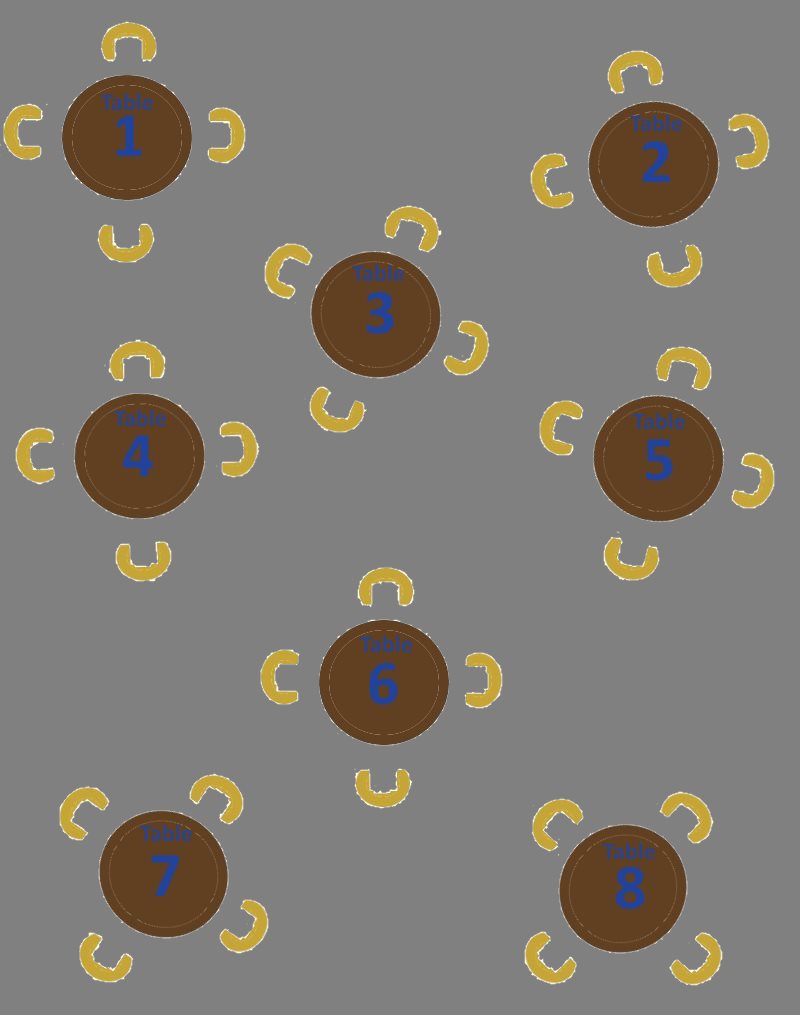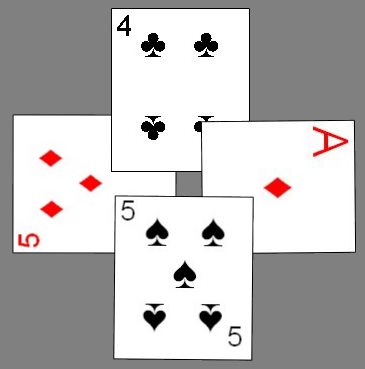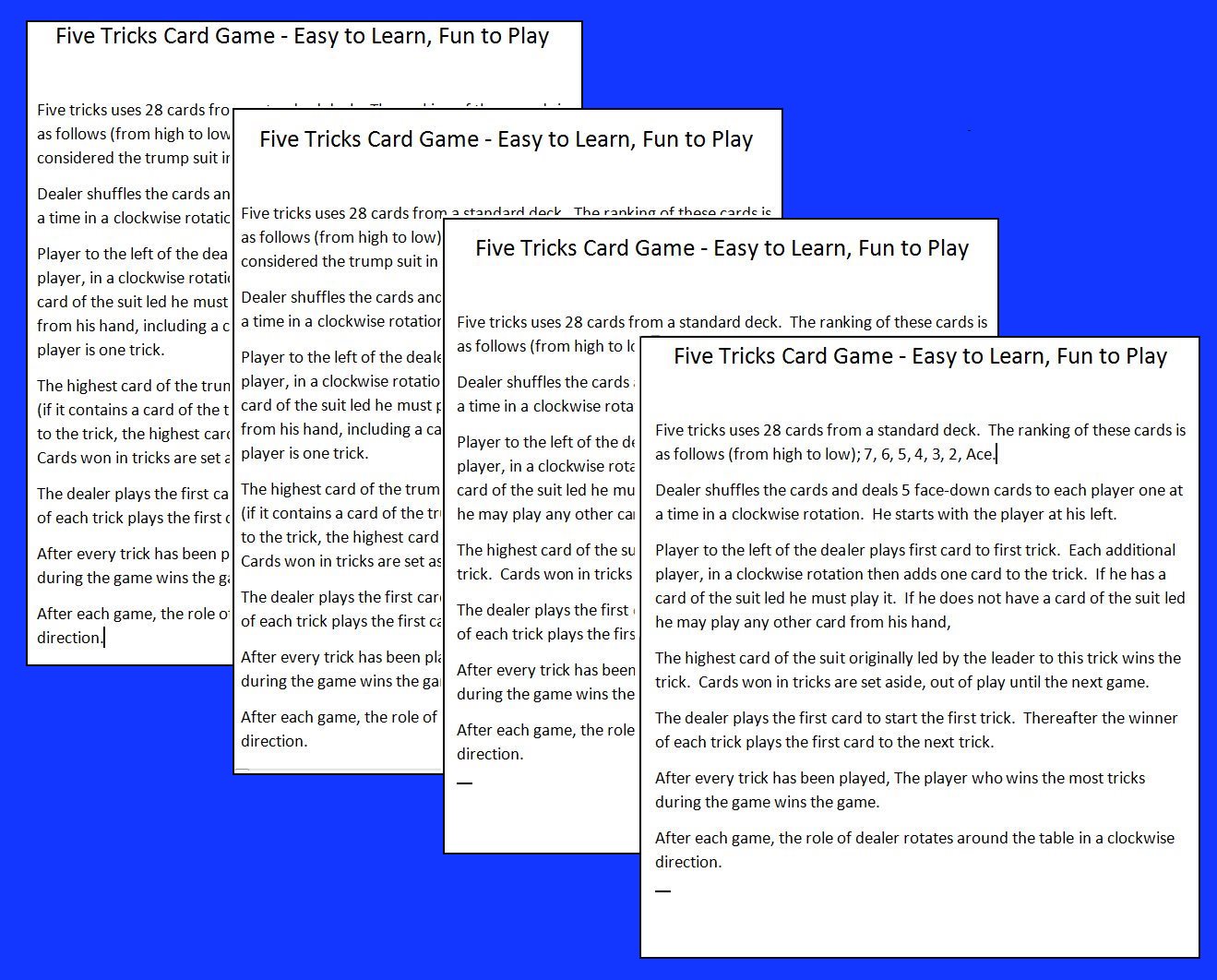Spoiler Alert: One of the strong points of the Barnga experience is the surprise element as the activity progresses. Thus, if you have not previously participated in Barnga and plan to do so at some time as an active participant, it is recommended to not read the details of the game unless you will be the facilitator of the game. Much more enjoyment and growth will come from participating in the activity for the first time as a new experience.
 Barnga was originally created in 1980 by Sivasailam “Thiagi” Thiagarajan. He was working in Liberia and during a coup in that Country (in which he and others were prohibited from leaving the area), he and his cohorts extensively played the game Euchre to pass the time. During these games, and because many of the participants in the game came from different cultural backgrounds, Thiagi had a brilliant idea and developed Barnga as a result. Barnga, usually arranged in a seminar setting or class activity, is designed for a very large number of participants (usually 9 to 40). The activity consists of a simple trick-taking game titled Five Tricks and a simulated tournament of this game. Before play, the participants should be divided into equal groups of three, four, or five players. Each such group should be seated at their own individual table. The ideal setup is for each table to have four players, but in many cases this is impossible due to the number of participants. In this case, some tables may have more or less players.
Barnga was originally created in 1980 by Sivasailam “Thiagi” Thiagarajan. He was working in Liberia and during a coup in that Country (in which he and others were prohibited from leaving the area), he and his cohorts extensively played the game Euchre to pass the time. During these games, and because many of the participants in the game came from different cultural backgrounds, Thiagi had a brilliant idea and developed Barnga as a result. Barnga, usually arranged in a seminar setting or class activity, is designed for a very large number of participants (usually 9 to 40). The activity consists of a simple trick-taking game titled Five Tricks and a simulated tournament of this game. Before play, the participants should be divided into equal groups of three, four, or five players. Each such group should be seated at their own individual table. The ideal setup is for each table to have four players, but in many cases this is impossible due to the number of participants. In this case, some tables may have more or less players.
A few necessary supplies should be provided at each table; several pencils, a blank sheet of paper (for keeping score), a set of instructions specifically for that table (described below) for a card game called Five Tricks, and a modified deck of cards. This deck consists of a modified standard deck. This deck should consist of all cards from a standard deck of denominations Ace, 2, 3, 4, 5, 6, 7. Each table is also often numbered for easier movement between tables by participants.
To begin, all the players are seated at the various tables and may review the rule sheet for playing the game. The players should be given approximately five minutes to practice playing and learning the rules. After this, the game facilitator collects all the rule sheets and a strict rule of silence is given. Thus, after this rule is given, no verbal communication is allowed amongst the players. They may only communicate by drawing pictures or gestures. However, no speech, sign language or writing of actual words is allowed.
After this the facilitator then announces a Five Tricks tournament is to be played (still with no verbal communication allowed). Based on the outcome of the game played at that table, some players will move to other tables. The winner (player who wins the most tricks) moves to the next highest numbered table and the player who loses the move tricks moves to the next lowest numbered table. At the highest numbered table, the winner moves to the first table. At the lowest numbered table, the player who wins the least tricks moves to the highest numbered table. When moving to the new table, the player may take any empty seat. If multiple players tie for the most or least tricks taken during the hand, they should each draw a card fro the remainder of the deck with the player drawing the highest ranked card (as per the table rules) moving to the appropriate table.
What the players are unaware of is that the rules are slightly different at each table. Thus, when a player moves to a different table there is bound to be some confusion in play, particularly with the restriction on verbal speech. This difference is the key concept of the activity, as, when the players move from to table to table during the course of the "tournament", the rules at the new table will be slightly different than that of the previous table.
There are different sets of rules, each printed on the rule sheet. Each table should thus have a different rule sheet.
Each round should consist of approximately five minutes, and the players should play 3 hands if time allows. The total number of tricks won and lost by each player should be recorded to determine the winner and loser of that round.
Five Tricks: While the majority of the rules are the same at each table, there are also several differences. The following are the ten rulesets for playing the game, corresponding with each table.
- Table 1
- Any player can shuffle, cut, and deal the cards, with each player receiving five total cards, dealt face-down in front of that player.
- The ranking of the cards in the deck are, from high to low; Ace, 7, 6, 5, 4, 3, 2.
- The player to the immediate left of the dealer plays the first card to the first trick. He may play any card of his choice from his hand.
- Each remaining player in a clockwise rotation around the table then plays exactly one card to the trick. If a player has a card of the same suit as led he must play it. If a player does not have such a card he may play any card remaining in his hand.
- The player who plays the highest card of the suit originally led to the trick wins the trick, placing these cards face-down to his side, out of play.
- The winner of each trick leads the first card to the next trick.
- The player who wins the most tricks is declared the winner of the hand.
- Table 2
- Any player can shuffle, cut, and deal the cards, with each player receiving five total cards, dealt face-down in front of that player.
- The ranking of the cards in the deck are, from high to low; 7, 6, 5, 4, 3, 2, Ace.
- The player to the immediate left of the dealer plays the first card to the first trick. He may play any card of his choice from his hand.
- Each remaining player in a clockwise rotation around the table then plays exactly one card to the trick. If a player has a card of the same suit as led he must play it. If a player does not have such a card he may play any card remaining in his hand, including a card from the trump suit.
- The suit of Diamonds is considered the trump suit for the game. The highest card in the suit of Diamonds played to the trick wins it. If no card in the suit of Diamonds was played to the trick the highest card of the suit originally led to the trick wins it. The winner should place the cards comprising the trick to the side and out of play.
- The winner of each trick leads the first card to the next trick.
- The player who wins the most tricks is declared the winner of the hand.
- Table 3
- Any player can shuffle, cut, and deal the cards, with each player receiving five total cards, dealt face-down in front of that player.
- The ranking of the cards in the deck are, from high to low; 7, 6, 5, 4, 3, 2, Ace.
- The player to the immediate left of the dealer plays the first card to the first trick. He may play any card of his choice from his hand.
- Each remaining player in a clockwise rotation around the table then plays exactly one card to the trick. If a player has a card of the same suit as led he must play it. If a player does not have such a card he may play any card remaining in his hand, including a card of the trump suit.
- The suit of Clubs is considered the trump suit for the game. The highest card in the suit of Clubs played to the trick wins it. If no card in the suit of Clubs was played to the trick the highest card of the suit originally led to the trick wins it. The winner should place the cards comprising the trick to the side and out of play.
- The winner of each trick leads the first card to the next trick.
- The player who wins the most tricks is declared the winner of the hand.
- Table 4
- Any player can shuffle, cut, and deal the cards, with each player receiving five total cards, dealt face-down in front of that player.
- The ranking of the cards in the deck are, from high to low; Ace, 7, 6, 5, 4, 3, 2.
- The player to the immediate left of the dealer plays the first card to the first trick. He may play any card of his choice from his hand.
- Each remaining player in a clockwise rotation around the table then plays exactly one card to the trick. If a player has a card of the same suit as led he must play it. If a player does not have such a card he may play any card remaining in his hand, including a card of the trump suit.
- The suit of Hearts is considered the trump suit for the game. The highest card in the suit of Hearts played to the trick wins it. If no card in the suit of Hearts was played to the trick the highest card of the suit originally led to the trick wins it. The winner should place the cards comprising the trick to the side and out of play.
- The winner of each trick leads the first card to the next trick.
- The player who wins the most tricks is declared the winner of the hand.
- Table 5
- Any player can shuffle, cut, and deal the cards, with each player receiving five total cards, dealt face-down in front of that player.
- The ranking of the cards in the deck are, from high to low; Ace, 7, 6, 5, 4, 3, 2.
- The player to the immediate left of the dealer plays the first card to the first trick. He may play any card of his choice from his hand.
- Each remaining player in a clockwise rotation around the table then plays exactly one card to the trick. If a player has a card of the same suit as led he must play it. If a player does not have such a card he may play any card remaining in his hand, including a card of the trump suit.
- The suit of Spades is considered the trump suit for the game. The highest card in the suit of Spades played to the trick wins it. If no card in the suit of Spades was played to the trick the highest card of the suit originally led to the trick wins it. The winner should place the cards comprising the trick to the side and out of play.
- The winner of each trick leads the first card to the next trick.
- The player who wins the most tricks is declared the winner of the hand.
- Table 6
- Any player can shuffle, cut, and deal the cards, with each player receiving five total cards, dealt face-down in front of that player.
- The ranking of the cards in the deck are, from high to low; 7, 6, 5, 4, 3, 2, Ace.
- The player to the immediate left of the dealer plays the first card to the first trick. He may play any card of his choice from his hand.
- Each remaining player in a clockwise rotation around the table then plays exactly one card to the trick. If a player has a card of the same suit as led he must play it. If a player does not have such a card he may play any card remaining in his hand.
- The player who plays the highest card of the suit originally led to the trick wins the trick, placing these cards face-down to his side, out of play.
- The winner of each trick leads the first card to the next trick.
- The player who wins the most tricks is declared the winner of the hand.
- Table 7
- Any player can shuffle, cut, and deal the cards, with each player receiving five total cards, dealt face-down in front of that player.
- The ranking of the cards in the deck are, from high to low; Ace, 7, 6, 5, 4, 3, 2.
- The player to the immediate left of the dealer plays the first card to the first trick. He may play any card of his choice from his hand.
- Each remaining player in a clockwise rotation around the table then plays exactly one card to the trick. If a player has a card of the same suit as led he must play it. If a player does not have such a card he may play any card remaining in his hand, including a card from the trump suit.
- The suit of Diamonds is considered the trump suit for the game. The highest card in the suit of Diamonds played to the trick wins it. If no card in the suit of Diamonds was played to the trick the highest card of the suit originally led to the trick wins it. The winner should place the cards comprising the trick to the side and out of play.
- The winner of each trick leads the first card to the next trick.
- The player who wins the most tricks is declared the winner of the hand.
- Table 8
- Any player can shuffle, cut, and deal the cards, with each player receiving five total cards, dealt face-down in front of that player.
- The ranking of the cards in the deck are, from high to low; 7, 6, 5, 4, 3, 2, Ace.
- The player to the immediate left of the dealer plays the first card to the first trick. He may play any card of his choice from his hand.
- Each remaining player in a clockwise rotation around the table then plays exactly one card to the trick. If a player has a card of the same suit as led he must play it. If a player does not have such a card he may play any card remaining in his hand, including a card of the trump suit.
- The suit of Clubs is considered the trump suit for the game. The highest card in the suit of Clubs played to the trick wins it. If no card in the suit of Clubs was played to the trick the highest card of the suit originally led to the trick wins it. The winner should place the cards comprising the trick to the side and out of play.
- The winner of each trick leads the first card to the next trick.
- The player who wins the most tricks is declared the winner of the hand.
- Table 9
- Any player can shuffle, cut, and deal the cards, with each player receiving five total cards, dealt face-down in front of that player.
- The ranking of the cards in the deck are, from high to low; Ace, 7, 6, 5, 4, 3, 2.
- The player to the immediate left of the dealer plays the first card to the first trick. He may play any card of his choice from his hand.
- Each remaining player in a clockwise rotation around the table then plays exactly one card to the trick. If a player has a card of the same suit as led he must play it. If a player does not have such a card he may play any card remaining in his hand, including a card of the trump suit.
- The suit of Hearts is considered the trump suit for the game. The highest card in the suit of Hearts played to the trick wins it. If no card in the suit of Hearts was played to the trick the highest card of the suit originally led to the trick wins it. The winner should place the cards comprising the trick to the side and out of play.
- The winner of each trick leads the first card to the next trick.
- The player who wins the most tricks is declared the winner of the hand.
- Table 10
- Any player can shuffle, cut, and deal the cards, with each player receiving five total cards, dealt face-down in front of that player.
- The ranking of the cards in the deck are, from high to low; 7, 6, 5, 4, 3, 2, Ace.
- The player to the immediate left of the dealer plays the first card to the first trick. He may play any card of his choice from his hand.
- Each remaining player in a clockwise rotation around the table then plays exactly one card to the trick. If a player has a card of the same suit as led he must play it. If a player does not have such a card he may play any card remaining in his hand, including a card of the trump suit.
- The suit of Spades is considered the trump suit for the game. The highest card in the suit of Spades played to the trick wins it. If no card in the suit of Spades was played to the trick the highest card of the suit originally led to the trick wins it. The winner should place the cards comprising the trick to the side and out of play.
- The winner of each trick leads the first card to the next trick.
- The player who wins the most tricks is declared the winner of the hand.
 |
| Which player should win this trick? |
 |
| Click this link to download the Barnga Five Tricks rule sheets, ready for ten different tables. |
The number of rounds played is often equal to the number of tables. However, if there is limited time, as many rounds as possible should be played.
 Debriefing: By the end of the tournament, the players will probably have realized that something is amiss and that different tables or players are playing by different rules. It should be described to the participants what has happened and how the rules were different at every table. If the game is part of an organized class activity or seminar, a debriefing should also occur to allow the participants to reflect on the activity and discuss how they felt and what happened. This is often led by the facilitator using a series of questions. A number of different questions can be used which should be customized to the particular goals of the seminar. The following are a few examples that might be used to help the participants discuss the activity:
Debriefing: By the end of the tournament, the players will probably have realized that something is amiss and that different tables or players are playing by different rules. It should be described to the participants what has happened and how the rules were different at every table. If the game is part of an organized class activity or seminar, a debriefing should also occur to allow the participants to reflect on the activity and discuss how they felt and what happened. This is often led by the facilitator using a series of questions. A number of different questions can be used which should be customized to the particular goals of the seminar. The following are a few examples that might be used to help the participants discuss the activity:
- What were you expecting at the start of the tournament?
- When did you realize something was amiss and how did you feel about it?
- How does this activity relate to a real life situation in which you were involved? Describe the situation and how you dealt with the situation.
- What did you do during the game to help deal with the challenges faced during play?
- How would you behave differently if you knew how the game works before beginning the tournament?